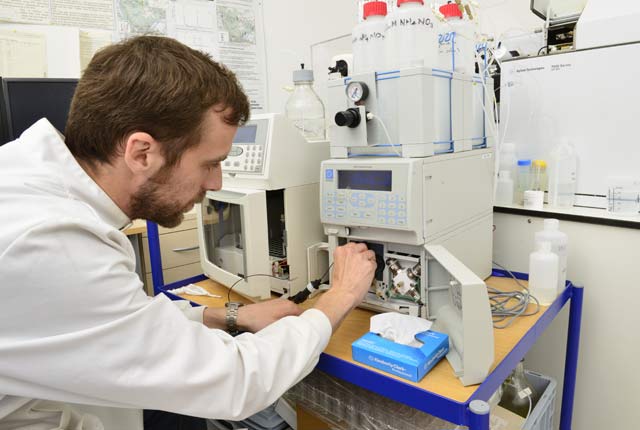Between March 2011 and March 2013, the BGS was commissioned by the UK Health Protection Agency (now part of Public Health England (PHE)) to undertake a sampling campaign of 512 properties in Cornwall served by private water supplies (PWS). This page provides additional information to the participants of the study.


A short film to explain to participants how the biomonitoring study of exposure to arsenic in private drinking water supplies in Cornwall will be undertaken. Please note that minor aspects of the study have changed since the filming of this video.
Exposure assessment
Results from the study showed that five per cent of drinking water samples collected exceeded the 10 μg/L prescribed concentration or value (PCV) for arsenic (As).
However, these results alone don’t tell the full story of population exposure to As in the region and, to go a step further in assessing exposure, a biomonitoring study was carried out. The newer study was a collaboration between the BGS and PHE, with the addition of the University of Manchester, through a jointly funded PhD studentship.
Methodology
The study explored the use of human biomarkers (urine, toenails and hair) to determine how much As — if any — was being taken up by the local population. It also included environmental monitoring of household dust, garden soil and rice. Study participants were interviewed to gather data for an assessment questionnaire, in an attempt to quantify the importance of a range of potential exposure routes.
Focus on Cornwall
Although the problem is likely of lesser concern in the UK, As is a documented carcinogen known to be the cause of a number of internal cancers in countries where heavily contaminated groundwater is utilised for human consumption.
Cornwall is a region known for high environmental As because of its highly mineralised geology. There are believed to be upwards of 3500 private water supplies in Cornwall, serving an estimated 9000 people (DWI, 2013).
Previous studies in the region have focused their attention on other exposure routes (mostly soil). The consumption of groundwater is an area warranting further research.
Progress update March 2016
Households were visited by BGS teams in November 2013, following an invite to take part in the biomonitoring study through direct mailing and followup calls. More than 120 households and more than 200 volunteers from across Cornwall participated.
The samples collected underwent a series of measurements for each of the sample types. The measurements for water data were reported in June 2014 to the households. Biological data was reported in March 2015, with soil sample data reported in March 2016 in consultation with Cornwall Council.
Communicating the results from the analysis of the soil samples to householders
Feedback of all the available results was completed when participants received the results of the analysis on their soil samples. Participants were sent the results of their soil samples by means of a letter. Participants received the individual concentrations of all of the soil samples collected from their garden for arsenic, cadmium, and lead. This is because these were the elements where a category 4 screening level (C4SL) exists and some exceedances occurred.
Participants could compare their results with the appropriate C4SL for their sample. Participants with levels of chemicals in their soil above a C4SL were informed and provided with general public health advice. They ere also given the phone number for Cornwall Council, as the regulator; the council were happy to provide individual advice to householders.
Why did it take so long?
A substantial number of checks during the analyses were undertaken to ensure the quality and reliability of the measurements and when matching the measurements with the volunteer records. All data was anonymised and secured, in accordance with ethical guidelines.
A range of sample types were collected and required bespoke measurements.
Advisory documents were prepared by PHE for households where measurements in all sample types exceeded recommended levels. This process was extremely complex, particularly where there was a lack of information in the scientific literature and so great care was required in providing any recommendations to households.
- Project update June 2014 (123 KB pdf)
- Reporting of biological data: March 2015 (197 KB pdf)
- Reporting of soil data: March 2016 (261 KB pdf)
Publications from this project
An overview of the water chemistry has recently been published: Variability in the chemistry of private drinking water supplies and the impact of domestic treatment systems on water quality.
Frequently asked questions
Please read the FAQs: Measuring biological levels of Arsenic in the population of Cornwall (118 KB pdf) if you have any questions about the study.
See also the private water supply (PWS) advice sheets (461 KB pdf).
Contact
If you have any further concerns about the project please feel free to call PHE helpline on 01235 825042 or email epht@phe.gov.uk
You may also be interested in

Science facilities
BGS operates and maintains a wide range of state-of-the-art laboratories and other facilities, which underpin virtually all of our research.

Centre for Environmental Geochemistry
Focusing on the use of geochemistry in research, training and teaching.

Inorganic Geochemistry Facility
Providing high-quality analytical expertise and specialist services for the production and geochemical interpretation of inorganic data.
Footnotes
1. advice sheets
DWI. 2013. Drinking Water 2012, Private water supplies in England. A report by the Chief Inspector of Drinking Water, July 2013.



